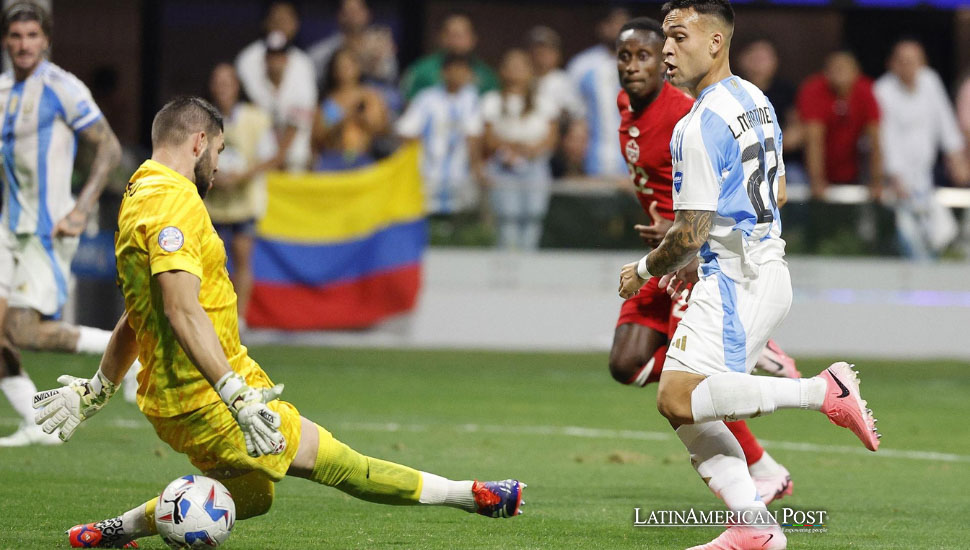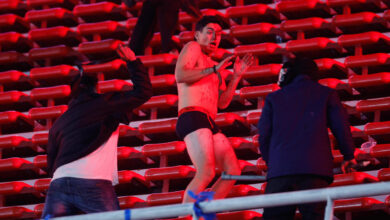Copa América 2024 Faces Pitch Challenges Amid High Stakes

Concerns over pitch conditions overshadow Copa América 2024, raising player safety issues and impacting the quality of play in the U.S.
The Copa América 2024 has brought goals, records, and excitement over four days of matches, with one more to close the first round. However, the tournament has also been marred by concerns about the state of the playing fields and fears of potential injuries among the teams.
“Yes, we saw what happened in the debut match (Argentina vs. Canada), where the pitch conditions were not what we all expected, especially for fluid and good soccer,” said Uruguayan defender Ronald Araújo on Saturday. “I think the pitch is the key to everything. I’m not saying it’s an excuse, but it’s the most important thing. If you want to see a show, I think the pitch has to be in the right condition for that,” he added.
Amidst the excitement of Copa América 2024, the expanded Club World Cup in 2025, and the 2026 World Cup shared with Mexico and Canada, the United States has much at stake if it wants to become a soccer powerhouse. Unfortunately, the condition of the playing fields has been an unwelcome protagonist in the early stages of the competition. This issue is not new in the U.S., where artificial turf, a surface known for its high heat retention and increased risk of player injuries, is commonly used in NFL stadiums, the largest in the country, and often repurposed for major soccer events.
Currently, 15 of the 30 NFL stadiums use synthetic surfaces, but both Copa América and the World Cup require natural grass, posing significant logistical challenges that are not always well resolved. “With all due respect, it’s a good thing we won because otherwise, it would have seemed like an excuse. We’ve known for seven months that we had to play here, and they changed the grass two days ago,” lamented Argentine coach Lionel Scaloni after their match against Canada at the Mercedes Benz Stadium in Atlanta. “The stadium is beautiful, and with synthetic turf, it must be spectacular, but it’s not suitable for these players,” he added.
Player Concerns and Risks
Players and coaches alike have echoed concerns about the state of the pitches. Kamal Miller, a Canadian defender, remarked that playing on that synthetic surface felt like “walking on a stage as if it were hollow.” Argentine players like Julián Álvarez (“the field was not in the best condition”), Cristian Romero (“the pitch conditions were evil”), and Emiliano Martínez (“we need to improve this aspect, or otherwise, the Copa América will always be a level below the Euro Cup”) expressed similar sentiments, emphasizing the impact of the pitch conditions on their performance and safety.
Ricardo Gareca, after Chile’s match against Peru at the AT&T Stadium in Arlington, joined the critical voices about the playing conditions. “According to the players, the field was dry with limited spaces. We will have to adapt, but there’s no doubt that some teams adapt better than others,” stated the Chilean coach. However, on Saturday, there was a respite on this issue as Venezuelan coach Fernando Batista and Ecuador’s Félix Sánchez were satisfied with the turf at Levi’s Stadium in Santa Clara. Additionally, U.S. coach Gregg Berhalter noted that the pitch at the AT&T Stadium was “much better” than during their Nations League match in March.
Fear of Injuries
It’s not just the quality of play that’s at risk; there is also a concern that poor pitch conditions might lead to more injuries during the tournament. Peruvian coach Jorge Fossati was particularly vocal after Luis Advíncula’s injury in their match against Chile. “I take into account that this is a grass pitch today, but it’s not the usual natural grass that grows and thrives; it’s grass brought from outside,” he said. “That can make it a bit harder and sometimes affect that part of the game. I’m not a doctor or anything like that, but I’ve been in soccer for quite a few years, and I know that Achilles tendon injuries can also come from that,” he added.
Mexican coach Jaime Lozano was more cautious, saying on Saturday that he didn’t believe Edson Álvarez’s injury was related to the pitch and was reasonably satisfied with the NRG Stadium in Houston. “I think it was good for playing; the grass didn’t affect it. It would be better if the natural grass were put in earlier, but I felt the field was in good condition,” he said.
A Broader Latin American Perspective
This year’s Copa América, being hosted in the U.S., highlights a broader issue concerning the adaptation of soccer infrastructure in a country where soccer is still growing compared to its Latin American neighbors. The use of artificial turf in NFL stadiums, frequently converted for soccer events, contrasts sharply with the soccer-specific stadiums in Latin America, where natural grass is the standard. This difference in infrastructure reflects the varying levels of investment and cultural emphasis on soccer between the regions.
In Latin America, soccer is more than just a sport; it’s a significant part of the cultural fabric, with deep historical roots and passionate fan bases. The commitment to maintaining high-quality natural grass pitches underscores the region’s deep-rooted love for the sport. For countries like Brazil, Argentina, and Uruguay, where soccer has a long and storied history, the idea of playing on anything but natural grass is almost unthinkable, highlighting the profound cultural significance of the sport.
The Road Ahead for U.S. Soccer
As the U.S. prepares to co-host the 2026 World Cup with Mexico and Canada, the current issues with the playing fields in Copa América serve as a critical reminder of the work that needs to be done. The push to convert artificial turf stadiums to natural grass for major international tournaments will require significant investment and planning. However, it also presents a promising opportunity for the U.S. to showcase its commitment to becoming a soccer powerhouse, instilling hope for the future of soccer in the country.
The influx of soccer superstars like Lionel Messi to Major League Soccer (MLS) has already boosted the sport’s profile in the country. The “Messimania” that swept the U.S. when the Argentine legend joined Inter Miami in 2023 is a testament to the growing interest and potential for soccer in the region. However, ensuring top-notch playing conditions is crucial for this momentum to continue.
The Copa América 2024 has highlighted the persistent issues with playing field conditions in the U.S., which pose challenges for the quality of play and for player safety. Addressing these concerns will be paramount as the country looks ahead to hosting even more significant soccer events. The experience of Latin American countries, where natural grass pitches are a given, offers valuable lessons for the U.S. as it strives to establish itself as a significant player in soccer.
Also read: Bolivia’s 1997 Copa América Near-Miss: A Soccer Legacy Remembered
By improving infrastructure and learning from the rich soccer traditions of its Latin American neighbors, the U.S. can ensure that its journey to becoming a soccer reference point is successful and sustainable.





